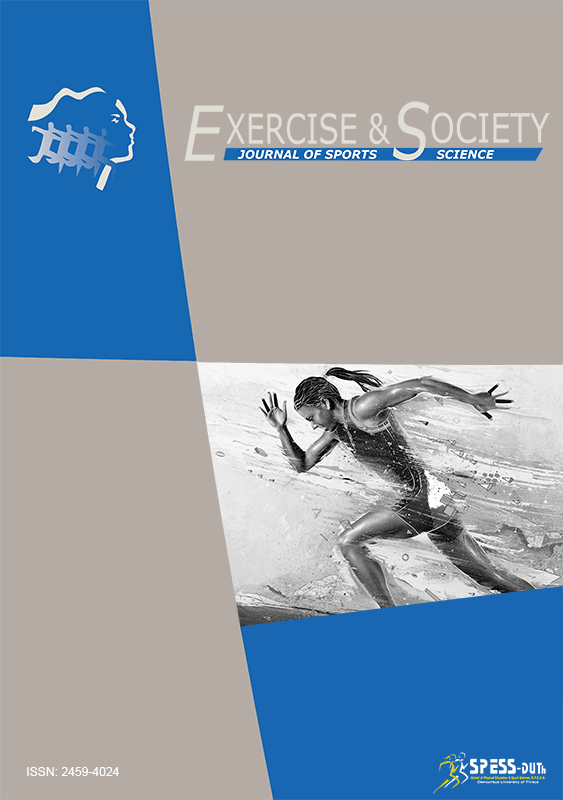The impact of a virtual reality intervention in kinesthetic ability of girls aged 8-10 years old
Abstract
The purpose of this study was to examine the effect of a virtual reality intervention on the kinesthetic ability of girls aged 8-10 years. The participants of the research were thirty-two (n=32) volleyball athletes aged 8-10 years, who were randomly divided in two groups. The FIVE group, that attended a kinesthetic training program based on full immersive virtual environments (Playstation Virtual Reality) and the TT group, that attended a kinesthetic program of Typical Training. The measuring tool that was used to assess kinesthetic ability in this research, was the kinesthesiometer (Lafayette Instruments Co, Lafayette, IN). The investigation of the initial differences between the two intervention groups for the average performance in the assessment of kinesthetic abilities, was determined by using a T-Test analysis for independent samples (independent-samples t‐test). For the statistical analysis of the data, was used the two-way analysis of variance with repeated measurements in the last factor (Two-Way Repeated Measures ANOVA). The data analysis revealed that the groups which attended the intervention programs (FIVE, TT) had a significant improvement in their kinesthetic ability, maintaining their performance measures one month after the intervention. In conclusion, activities that are completely based on virtual environments cannot replace girls' participation in actual volleyball activities that promote kinesthetic ability, but they can offer an extra capacity by helping them remove the obstacles that they maybe face, during their participation in these sports activities.References
Abdul Jabbar, A. I., & Felicia, P. (2015). Gameplay engagement and learning in game-based learning: A systematic review. Review of educational research, 85(4), 740-779.
Bacard, A. (1993). Welcome to virtual reality. Humanist, 53(2), 42-43.
Barnett, L. M., Bangay, S., McKenzie, S., & Ridgers, N. (2013). Active gaming as a mechanism to promote physical activity and fundamental movement skill in children. Frontiers in public health, 1, 74.
Boyle, E., Connolly, T. M., & Hainey, T. (2011). The role of psychology in understanding the impact of computer games. Entertainment computing, 2(2), 69-74.
Gioftsidou, A., Vernadakis, N., Malliou, P., Batzios, S., Sofokleous, P., Antoniou, P., & Godolias, G. (2013). Typical balance exercises or exergames for balance improvement? Journal of back and musculoskeletal rehabilitation, 26(3), 299-305.
Hsu, T. Y. (2016). Effects of Wii Fit® balance game training on the balance ability of students with intellectual disabilities. Journal of physical therapy science, 28(5), 1422-1426.
Papastergiou, M. (2009). Exploring the potential of computer and video games for health and physical education: A literature review. Computers & Education, 53(3), 603-622.
Ravi, D. K., Kumar, N., & Singhi, P. (2017). Effectiveness of virtual reality rehabilitation for children and adolescents with cerebral palsy: an updated evidence-based systematic review. Physiotherapy, 103(3), 245-258.
Roemmich, J. N., Lambiase, M. J., McCarthy, T. F., Feda, D. M., & Kozlowski, K. F. (2012). Autonomy supportive environments and mastery as basic factors to motivate physical activity in children: a controlled laboratory study. International Journal of Behavioral Nutrition and Physical Activity, 9(1), 1-13.
Schmidt, R.A. & Lee, T.D. (1999). Motor control and learning: a behavioral emphasis. Champaign, IL: Human Kinetics.
Swanson, L. R., & Lee, T. D. (1992). Effects of aging and schedules of knowledge of results on motor learning. Journal of gerontology, 47(6), P406–P411.
Shih, C. H. (2011). A standing location detector enabling people with developmental disabilities to control environmental stimulation through simple physical activities with Nintendo Wii Balance Boards. Research in developmental disabilities, 32(2), 699-704.
Slater, M., Usoh, M., & Steed, A. (1994). Depth of presence in virtual environments. Presence: Teleoperators & Virtual Environments, 3(2), 130-144.
Τζέτζης, Γ. & Λόλα, Α. (2015). Κινητική Μάθηση και Ανάπτυξη, Αθήνα: Ελληνικά Ακαδημαϊκά Συγγράμματα και Βοηθήματα.
Vernadakis, N., Gioftsidou, A., Antoniou, P., Ioannidis, D., & Giannousi, M. (2012). The impact of Nintendo Wii to physical education students' balance compared to the traditional approaches. Computers & Education, 59(2), 196-205.
Vernadakis, N., Derri, V., Tsitskari, E., & Antoniou, P. (2014). The effect of Xbox Kinect intervention on balance ability for previously injured young competitive male athletes: a preliminary study. Physical Therapy in Sport, 15(3), 148-155.
Vernadakis, N., Kouli, O., Tsitskari, E., Gioftsidou, A., & Antoniou, P. (2014). University students' ability-expectancy beliefs and subjective task values for exergames. Computers & Education, 75, 149-161.
Vernadakis, N., Papastergiou, M., Zetou, E., & Antoniou, P. (2015). The impact of an exergame-based intervention on children's fundamental motor skills. Computers & Education, 83, 90-102.
Yen, C. Y., Lin, K. H., Hu, M. H., Wu, R. M., Lu, T. W., & Lin, C. H. (2011). Effects of virtual reality–augmented balance training on sensory organization and attentional demand for postural control in people with Parkinson disease: a randomized controlled trial. Physical therapy, 91(6), 862-874.
Zisi, V., Michalopoulou, M., Tzetzis, G., & Kioumourtzoglou, E. (2001). Effects of a short-term exercise program on motor function and whole-body reaction time in the elderly. Journal of Human Movement Studies, 40(2), 145-160.
Zisi, V., Derri, V., & Hatzitaki, V. (2003). Role of perceptual and motor abilities in instep-kicking performance of young soccer players. Perceptual and motor skills, 96(2), 625-636.
Downloads
Published
How to Cite
Issue
Section
License
Authors who publish with this journal agree to the following terms:
a. Authors retain copyright and grant the journal right of first publication with the work simultaneously licensed under a Creative Commons Attribution License that allows others to share the work with an acknowledgement of the work's authorship and initial publication in this journal.
b. Authors are able to enter into separate, additional contractual arrangements for the non-exclusive distribution of the journal's published version of the work (e.g., post it to an institutional repository or publish it in a book), with an acknowledgement of its initial publication in this journal.
c. Authors are permitted and encouraged to post their work online (e.g., in institutional repositories or on their website) prior to and during the submission process, as it can lead to productive exchanges, as well as earlier and greater citation of published work (See The Effect of Open Access).


